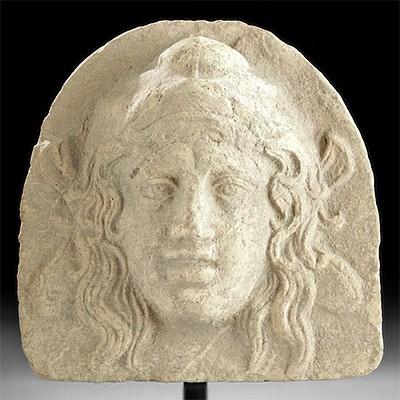South Arabian Qataban Limestone Stele
Lot 93
About Seller
Artemis Fine Arts
686 S Taylor Ave, Ste 106
Louisville, CO 80027
United States
Selling antiquities, ancient and ethnographic art online since 1993, Artemis Gallery specializes in Classical Antiquities (Egyptian, Greek, Roman, Near Eastern), Asian, Pre-Columbian, African / Tribal / Oceanographic art. Our extensive inventory includes pottery, stone, metal, wood, glass and textil...Read more
Categories
Estimate:
$2,500 - $3,500
Absentee vs Live bid
Two ways to bid:
- Leave a max absentee bid and the platform will bid on your behalf up to your maximum bid during the live auction.
- Bid live during the auction and your bids will be submitted real-time to the auctioneer.
Bid Increments
| Price | Bid Increment |
|---|---|
| $0 | $25 |
| $300 | $50 |
| $1,000 | $100 |
| $2,000 | $250 |
| $5,000 | $500 |
| $10,000 | $1,000 |
| $20,000 | $2,500 |
| $50,000 | $5,000 |
| $100,000 | $10,000 |
| $200,000 | $20,000 |
About Auction
By Artemis Fine Arts
Feb 27, 2020
Set Reminder
2020-02-27 10:00:00
2020-02-27 10:00:00
America/New_York
Bidsquare
Bidsquare : VARIETY SALE | Antiquities & Ethnographic Art
https://www.bidsquare.com/auctions/artemis-gallery/variety-sale-antiquities-ethnographic-art-4920
Around the world & back in time - be amazed at the treasures you will find. Antiquities from Egypt, Greece, Italy and the Near East, Asian, Pre-Columbian, African / Tribal / Oceanic, Native American, Spanish Colonial, Russian Icons, Fine Art, much more! Artemis Fine Arts info@artemisgallery.com
Around the world & back in time - be amazed at the treasures you will find. Antiquities from Egypt, Greece, Italy and the Near East, Asian, Pre-Columbian, African / Tribal / Oceanic, Native American, Spanish Colonial, Russian Icons, Fine Art, much more! Artemis Fine Arts info@artemisgallery.com
- Lot Description
Middle East, South Arabia, Qatabanian culture, ca. 3rd century BCE to 1st century CE. A striking pale brown limestone slab, a high-relief stele, with a carved abstract face with a triangular nose, deep set oval eyes, a small mouth, prominent brow ridge and well-groomed eyebrows, and the suggestion of a crown or headdress. One of the eyes is still inlaid with white shell (as they both would have been), giving the face a wide-eyed stare. Ears are carved in relief against the sides. At one time, there would have been a lower section incised with a memorial text. Size: 6.9" W x 6.75" H (17.5 cm x 17.1 cm); 8.5" H (21.6 cm) on included custom stand.
The deceased in this part of the world were often represented by anthropomorphic funerary stelae like this one; however, the face is highly stylized and it is doubtful that this is a portrait of a known individual. They have been found in three areas, one of which was the cemetery at Tamna, the capital city of Qataban. The Kingdom of Qataban rose to prominence in the second half of the 1st millennium BCE because it controlled the trade in frankincense and myrrh, incenses required to be burned at altars during religious rituals further north and west. A haunting and quite unique object, certain to spark conversation, and a reminder of the deeper history of the Middle East.
Provenance: ex-William Froelich collection, New York, USA, acquired in the 1970s
All items legal to buy/sell under U.S. Statute covering cultural patrimony Code 2600, CHAPTER 14, and are guaranteed to be as described or your money back.
A Certificate of Authenticity will accompany all winning bids.
We ship worldwide and handle all shipping in-house for your convenience.
#140466This is a fragment of a larger piece as shown, with the face preserved in nice condition and one of the inlaid shell eyes remaining. Small loss to the edge of the shell eye. Wear and weathering on the surface commensurate with age.Condition
- Shipping Info
-
All shipping is handled in-house for your convenience. Your invoice from Artemis Gallery will include shipping calculation instructions. If in doubt, please inquire BEFORE bidding for estimated shipping costs for individual items.
-
- Buyer's Premium



 EUR
EUR CAD
CAD AUD
AUD GBP
GBP MXN
MXN HKD
HKD CNY
CNY MYR
MYR SEK
SEK SGD
SGD CHF
CHF THB
THB














